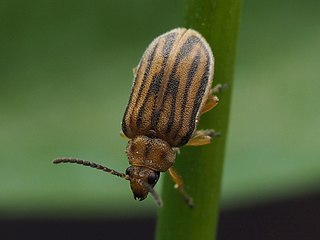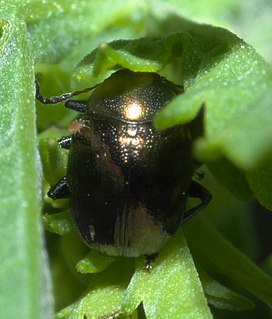
Amphizoa is a genus of aquatic beetles in the suborder Adephaga, placed in its own monogeneric family, Amphizoidae. There are five known species of Amphizoa, three in western North America and two in eastern palearctic. They are sometimes referred to by the common name troutstream beetles.

Dermestidae are a family of Coleoptera that are commonly referred to as skin beetles. Other common names include larder beetle, hide or leather beetles, carpet beetles, and khapra beetles. There are approximately 500 to 700 species worldwide. They can range in size from 1 to 12 mm. Key characteristics for adults are round oval shaped bodies covered in scales or setae. The usually clubbed antennae fit into deep grooves. The hind femora also fit into recesses of the coxa. Larvae are scarabaeiform and also have setae.

Cryptolaemus montrouzieri, common name mealybug ladybird or mealybug destroyer, is a ladybird species.

Oiceoptoma noveboracense is a member of the family Silphidae, or carrion beetles, which feed on decaying organic matter such as dead animals. Its common name is the margined carrion beetle, from the orange-red margins on the pronotum, which are helpful when identifying this species. The larva is typically light brown to red and also has vertical ridges on its thorax like the adult. This diurnal beetle can be found mainly in the spring into the fall, and it has a strong preference towards a deciduous forest habitat. The primary forensic importance of this beetle is its ability to use the succession of insect fauna to provide confirmation of postmortem intervals.

Hydrochus is a genus of water scavenger beetles in the monogeneric family Hydrochidae, sometimes placed in the Hydrophilidae as a subfamily Hydrochinae. The family Hydrochidae includes about 180 species, all of which are placed in the genus Hydrochus. Hydrochus has also been used for a fly genus in the family Dolichopodidae. This junior homonym is a junior subjective synonym of the genus Rhaphium.

Hippodamia variegata, the Adonis ladybird, also known as the variegated ladybug (US) and spotted amber ladybeetle (Aus), is a species of ladybeetle belonging to the family Coccinellidae, subfamily Coccinellinae.

Ophraella communa, common name ragweed leaf beetle, is a species of beetles belonging to the family Chrysomelidae.

Aphidecta obliterata is a species of Coccinellidae, a flying beetle.

Bembidion semicinctum is a species of ground beetle in the family Carabidae, in the suborder Adephaga. It was described by American entomologist Howard Notman in 1919.

Eumolpini is a tribe of leaf beetles in the subfamily Eumolpinae. It is the largest tribe in the subfamily, with approximately 170 genera found worldwide. Members of the tribe almost always have a longitudinal median groove on the pygidium, which possibly helps to keep the elytra locked at rest. They also generally have a subglabrous body, as well as appendiculate pretarsal claws.
Xyloterinus is a genus of typical bark beetles in the family Curculionidae. This is a monotypic genus and the one described species is Xyloterinus politus. It is native to North America where it infests both hardwood and softwood trees, as well as stacks of logs.
Neohaemonia nigricornis is a species of aquatic leaf beetle in the family Chrysomelidae found in North America. Its range includes the northern United States and southern Canada.
Spintherophyta is a genus of leaf beetles in the subfamily Eumolpinae. Most species in the genus are found in Central and South America, but there are also a few North American species.
Chaetocnema denticulata, the toothed flea beetle, is a species of flea beetle in the family Chrysomelidae. It is found in North America.
Colaspis arizonensis is a species of leaf beetle from North America. It is found in southeast Arizona and northwest Mexico. It was first described by the American entomologist Charles Frederic August Schaeffer in 1933.
Omophron americanum, the American round sand beetle, is a species of ground beetle in the family Carabidae. It is found in, as well as native to, North America, ranging across most of the United States and Canada, except British Columbia.

Hemisphaerota cyanea, known generally as palmetto tortoise beetle, is a species of leaf beetle in the family Chrysomelidae. Other names include the Florida tortoise beetle and iridescent blue chrysomelid beetle. It is native to the southeastern United States, from North Carolina, south to Florida, and west to Mississippi. It is introduced to southern Texas.

Gratiana pallidula, the eggplant tortoise beetle, is a species of tortoise beetle in the family Chrysomelidae. It is found in Central America and North America.
Spintherophyta globosa is a species of leaf beetle found in North America. It is widespread east of the Rocky Mountains, its range spanning from the East Coast west to Colorado and western Texas, and it may also occur in Arizona and Mexico. Its body is globose and colored black to dark brown, while the legs, antennae and mouth-parts are red-orange in color. The species is reported to be polyphagous.
Naemia seriata, commonly known as the seaside lady beetle, is a large coccinellid beetle native to North America, and the only species in the genus Naemia. It is found in coastal areas such as beaches, salt marshes, and bay islands on the Atlantic and Pacific coast. This beetle is light brown, yellow, orange, or red in color, with large black spots, often connected along the sides. The pronotum usually has one large central black spot, which is occasionally split into two spots. The body of this species is elongately oval in shape, and between 4 and 6.7mm in length. The two subspecies can be distinguished by markings on the head, with the head of N. seriata seriata being black, while the head of N. seriata litigiosa has a pale triangular marking. Naemia seriata seriata is primarily distributed across Eastern North America, while N. seriata litigiosa is restricted to the American Southwest.











